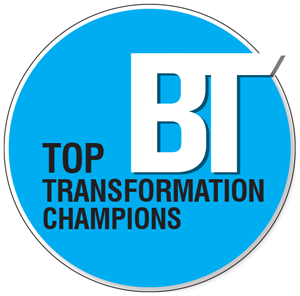Top Transformation Champions: Mitigating the digital transformation challenge

 In the post-COVID world, there is an increased impetus for digital transformation across organisations. This is fuelled by the evolution of advanced IT infrastructure solutions, data security, a data-driven approach, the Internet of Things, and Artificial Intelligence.
In the post-COVID world, there is an increased impetus for digital transformation across organisations. This is fuelled by the evolution of advanced IT infrastructure solutions, data security, a data-driven approach, the Internet of Things, and Artificial Intelligence.
The availability of the right IT infrastructure and the evolution of technologies like 5G, edge computing, hyperscale datacentres, etc. creates a platform for any business to leverage data in a way that allows them to make data-driven decisions faster while increasing efficiency and reducing errors.
Marketing campaigns, improving the overall customer and employee experience, and capacity building are areas where digital and business transformation solutions have helped businesses.
Sectors like education, healthcare, manufacturing, and financial services are leading the way in the adoption of digital and business transformation. Going forward, government spending will see an increase and will be key to the successful delivery of government schemes.
In terms of evolving technologies, 5G will be one of the most significant technology implementations shaping the future. By offering very high bandwidth up to 20 GB per second and low latency of less than one millisecond, 5G will become a serious driver for safer autonomous vehicles and it will help push the smart city concept.
Edge computing and edge datacentres will also grow in significance enabling low latency, high-speed transmission of data that myriad connected devices require. Similarly, the metaverse can be a serious business disruptor, provided the consumer adoption journey is easy, simple, and exciting.
The metaverse market will be driven by the consumer experience. While it is at a very nascent stage now, if successful, it can provide a plethora of options to businesses on how to connect with the consumer. It will demand a high-speed infrastructure and may lead to the implementation of 400 and 800 GB per second infrastructure solutions much faster.
Metaverse depends on the network on which it is based, so a sound IT infrastructure will be the key. Today, there is a myriad of devices and sensors connected to IP-based networks and communicating via common protocols. This enables systems and applications to share and analyse information to help make strategic decisions, enabling businesses to achieve real digital transformation.
A fundamental aspect of digital and business transformation is the increased use of data within organisations. For companies to become successful with digital transformation initiatives, the collection and analysis of data are key. They drive the automation and optimisation of business processes, leading to increased adoption of technologies such as Artificial Intelligence and Machine Learning.
It is also important that companies start measuring and reporting their carbon footprint based on carbon accounting metrics as per the universally accepted standards. The Greenhouse Gas Protocol sets the standard for calculating carbon emissions and at a minimum, companies should cover both Scope 1 and Scope 2 emissions.
The Science Based Target initiative or SBTi sets the most widely accepted global targets for reducing carbon emissions. The targets set are tight and committing to SBTi targets should be a key activity within a company’s sustainability efforts.
The lack of a properly selected and installed IT infrastructure, however, might stand in the way of collecting data from multiple systems and devices.
There has also been an increase in security threats such as cyberattacks in recent months. This has certainly stalled digital and business transformation initiatives since organisations are holding back investment in digital technologies. Other reasons include a lack of the right products or solutions in the market, budgetary constraints, and the non-availability of an experienced team for implementation.
Change management and a detailed digital transformation strategy are two key elements that can accelerate digital transformation and the adoption of digital technologies. A digital transformation strategy will determine which elements, systems and processes of the organisation need to be digitalised and why. This will determine which digital technologies to implement.
For top executives, the biggest challenge could be the availability of sufficient resources, both employees and budget. Digitally transforming an organisation requires a specific skill set, particularly in the IT and technical departments but the market is currently facing a shortage of skilled employees.
An adequate budget for any planned digital transformation work is another challenge. Organisations must thoroughly work out their digital transformation strategy to determine future expenditures and accurately calculate them.
Key takeaways
- 5G, edge computing, and hyperscale datacentres allow businesses to take data-driven decisions faster.
- A fundamental aspect of digital and business transformation is the increased use of data within organisations.
- Edge computing enables low-latency, high-speed transmission of data for myriad connected devices.
- The lack of a proper IT infrastructure can impact the way data is collected from multiple systems and devices.
- Organisations must thoroughly work out their digital transformation strategy to determine future expenditures.






